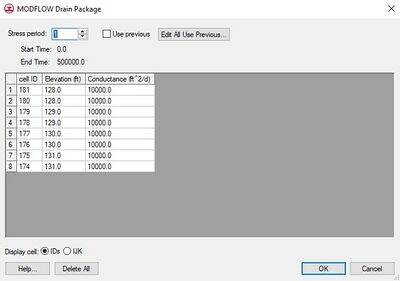GMS:DRN Package: Difference between revisions
From XMS Wiki
Jump to navigationJump to search
No edit summary Tag: Manual revert |
|||
| (6 intermediate revisions by 2 users not shown) | |||
| Line 1: | Line 1: | ||
{{MODFLOW Links}} | {{MODFLOW Links}} | ||
The Drain package is used to simulate the effect of drains on an aquifer. Drains remove water from the aquifer as long as the water table is above the elevation of the drain. If the water table falls below the elevation of the drain, the drain has no effect. The rate of removal is proportional to the difference in elevation between the water table and the drain. The constant of proportionality is the conductance of the fill material surrounding the drain. | The Drain package (DRN) is used to simulate the effect of drains on an aquifer. Drains remove water from the aquifer as long as the water table is above the elevation of the drain. If the water table falls below the elevation of the drain, the drain has no effect. The rate of removal is proportional to the difference in elevation between the water table and the drain. The constant of proportionality is the conductance of the fill material surrounding the drain. | ||
A set of selected cells can be specified as drains using the '''Point Sources/Sinks''' command in the ''MODFLOW'' menu or drains can be defined using the [[GMS:MODFLOW Conceptual Model Approach|conceptual model]] approach in the map module. Drains are specified by assigning an elevation and a conductance to each cell at the location of each drain. | A set of selected cells can be specified as drains using the '''Point Sources/Sinks''' command in the ''MODFLOW'' menu or drains can be defined using the [[GMS:MODFLOW Conceptual Model Approach|conceptual model]] approach in the map module. Drains are specified by assigning an elevation and a conductance to each cell at the location of each drain. | ||
| Line 11: | Line 11: | ||
===Stress Period=== | ===Stress Period=== | ||
This field shows the current stress period and allows | This field shows the current stress period and allows users to cycle through the stress periods and view the different river properties for those stress periods in the spreadsheet below. | ||
===Use Previous === | ===Use Previous === | ||
| Line 28: | Line 28: | ||
The '''Delete All''' button deletes all of the data currently defined in the River package and restores the River package parameters to the default values. | The '''Delete All''' button deletes all of the data currently defined in the River package and restores the River package parameters to the default values. | ||
[[File:MODFLOWdrain.jpg|thumb|none|left| | [[File:MODFLOWdrain.jpg|thumb|none|left|400 px|The ''MODFLOW Drain Package'' dialog.]] | ||
| Line 35: | Line 35: | ||
[[Category:MODFLOW]] | [[Category:MODFLOW]] | ||
[[Category:MODFLOW Packages]] | [[Category:MODFLOW Packages]] | ||
[[Category: | [[Category:MODFLOW Dialogs]] | ||
[[Category:MODFLOW-USG]] | |||
